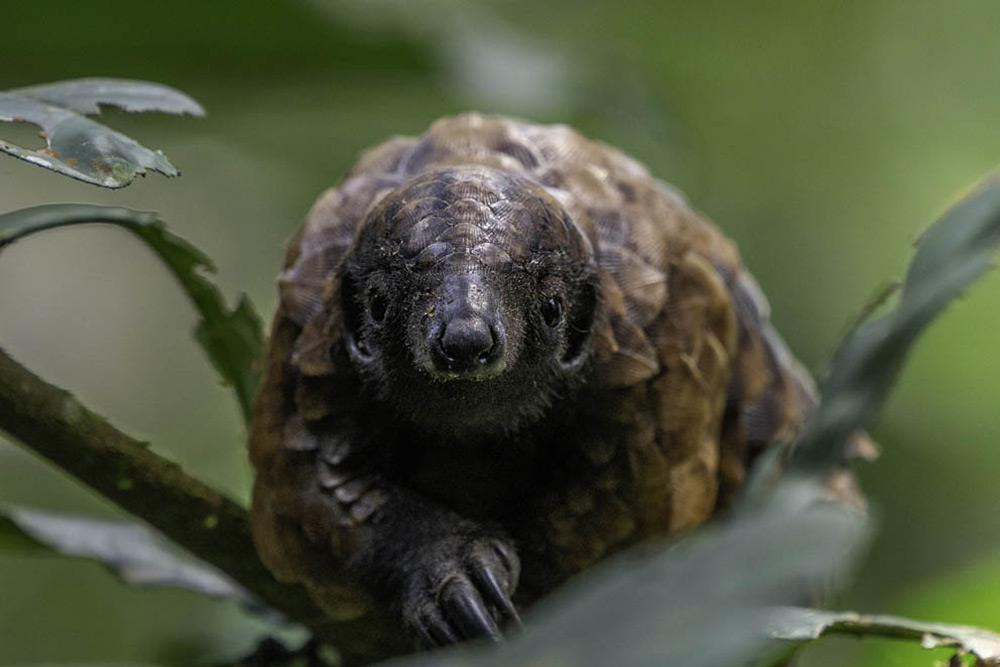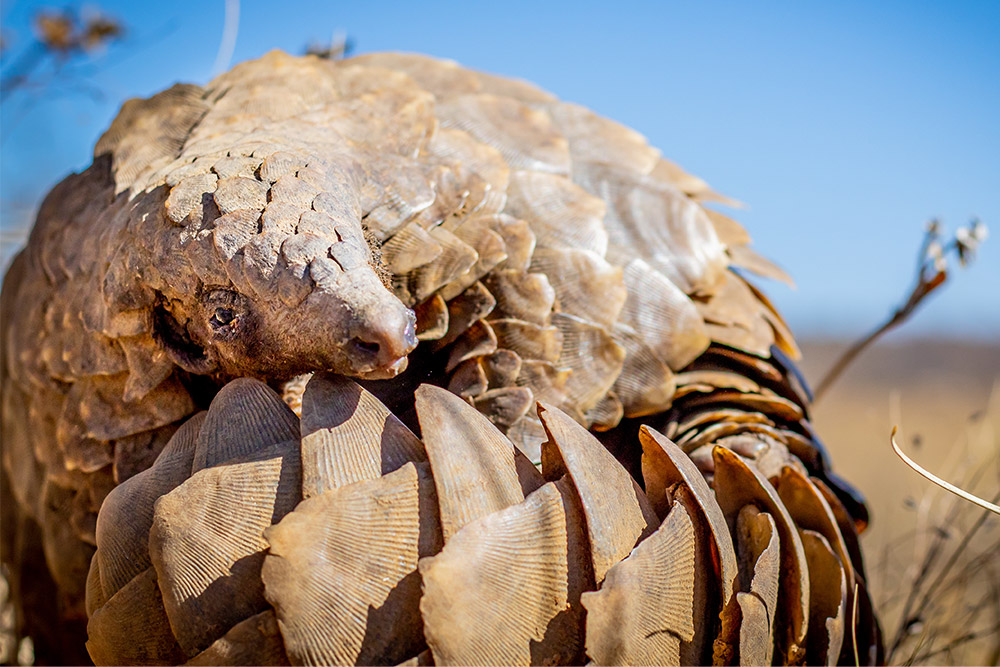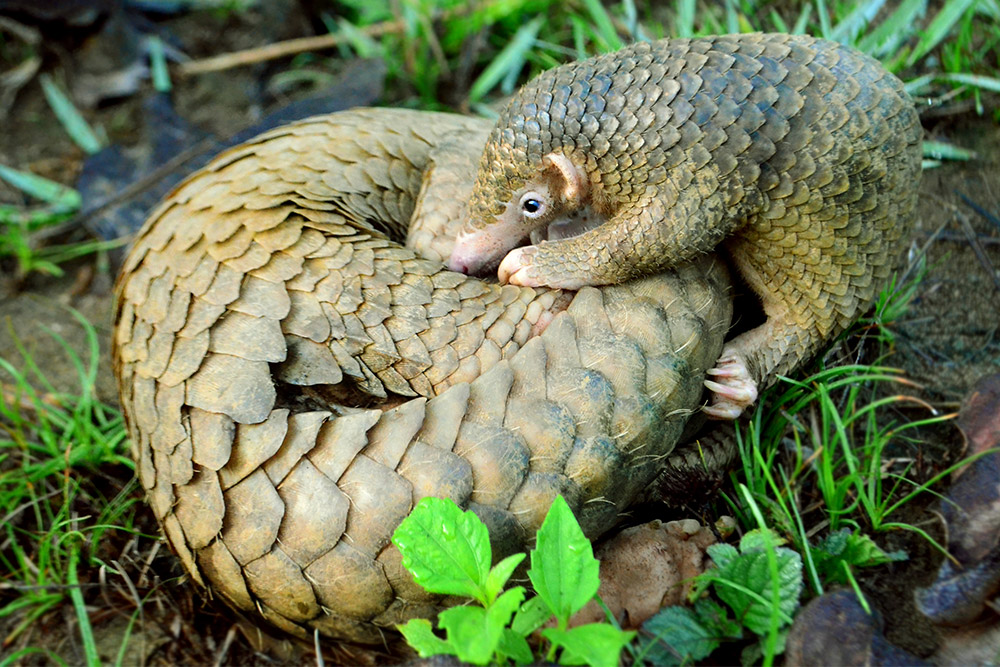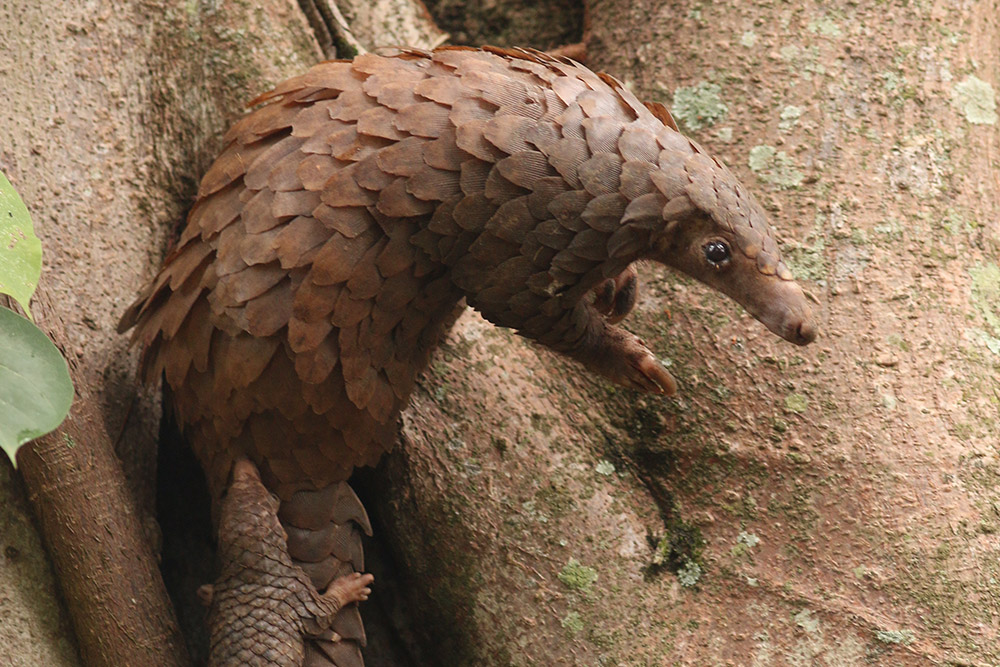PANGOLIN
Kulu’s Journey
“It’s an ancient creature that runs the risk of extinction. A creature that is unicorn-type status. Because that’s what it is. It’s so rare.”
— Professor Ray Jansen
PANGOLIN
KULU’S JOURNEY
From the Academy Award-winning director of My Octopus Teacher comes Pangolin: Kulu’s Journey, a poignant exploration of the connection between humans and the creatures we share our world with.
“an intimate and gripping fight-back story that eloquently reminds us of the importance of the connection between humans and the natural world.”
– Amber Wilkinson, Screen Daily
WHAT IS A PANGOLIN?
Pangolins have been on Earth for 85 million years. Often referred to as “living fossils,” they are the only mammal ever known to be covered in scales. There are eight species of pangolins – four in Africa and four in Asia.
Pangolin conservationists describe them as sensitive, quirky, charming, and full of personality. All pangolins want to do is what nature intended, to fit into a perfect ecosystem, going about their business of eating ants and termites, tilling the soil like nature’s gardener.
“IF WE LOSE SUCH A SPECIAL CREATURE LIKE A PANGOLIN, IT’S A SYMBOL OF HOW WE TREAT EVERYTHING”
— Nicci Wright
Pangolins are some of the most unique, gentle and innocent creatures that have ever walked the Earth (unless you are an ant). They can’t run, they can’t bite you and their only defence is to roll up into a ball. This is actually a very effective protection mechanism when it comes to most animal predators, but it makes them completely vulnerable to humans.
In certain African cultures, the pangolin is linked to wisdom and mystery. Its elusive nature and nocturnal habits contribute to its enigmatic reputation, with some communities viewing it as a creature that bridges the physical and spiritual realms, offering insights into hidden knowledge.
Its unique ability to curl into a ball, using its tough scales as armor, translates to safeguarding oneself and one’s community. This inspires belief in the pangolin’s role as a guardian spirit, offering defense against physical and spiritual threats.
They are more than just animals; they are symbols of protection, spirituality, and tradition.
As burrowing animals they are also magnets for biodiversity, providing shelter in their burrows, and resources for numerous other organisms, thus enriching the ecological tapestry of their habitats.
They have been here for 85 million years and have an important place in the web of life. Pangolins belong here on Earth with us.
Why are Pangolins special?
“What has our kind done to the Kulu kind?”
— Dr Caswell Munyai
WHY ARE PANGOLINS SO THREATENED?
A PANGOLIN IS POACHED EVERY FIVE MINUTES.
This makes them the most poached mammal on Earth, threatened with extinction at the hands of man.
African and Asian cultures exhibit a complex relationship with pangolins, intertwining respect, tradition, and economic activity. The current exploitation of pangolins is wholly unsustainable and has led to all eight species being classified as threatened, with three being critically endangered.
The exploitation of pangolins for traditional medicine and meat, along with habitat loss, deforestation, and human encroachment is placing this unique order under significant pressure. The IUCN estimates that over one million pangolins are estimated to have been illegally traded in the past decade.
Without fast and efficient action, pangolins could be extinct in the wild within 10 years.
Over one million pangolins are estimated to have been illegally traded in the past decade.
TRADITIONAL MEDICINE
One of the many distinguishing features of pangolins is their armor-like scales, which serve to protect them from predators -yet it is these very scales that make pangolins highly coveted by humans. Currently, there is a significant demand for pangolin scales in Asian markets, primarily in China and Vietnam, where they are used in the formulation of certain traditional medicines. Lacking any defences against human exploitation, pangolins have become the most illegally trafficked wild mammals in the world.
The recent commercial demand for pangolin scales has nearly depleted pangolin populations across Asia, giving rise to a global illegal trade in pangolins from Africa. Wildlife criminals on both continents engage in poaching and trafficking pangolins to black markets. Despite the scale of the issue, there remain large knowledge gaps regarding the illegal pangolin trade that make combating it an ongoing challenge. Authorities worldwide frequently confiscate substantial shipments of pangolin scales en route to Asia; however, greater financial resources and political will are essential to identify trade routes, disrupt trafficking networks, and eliminate the corruption that fuels this detrimental trade.
Traditional remedies that incorporate pangolin scales are deeply rooted in Traditional Chinese Medicine (TCM), a medical system that has existed alongside pangolins for thousands of years. However, in recent times, human population growth, modernization, and an expanding diaspora have led to the industrialization of TCM. The reverence and respect once associated with pangolins have been overshadowed by a relentless pursuit to satisfy the demands of commercial markets.
Many consumers who purchase these pharmaceutical off the shelf products from TCM pharmacies are often unaware that they contain pangolin scales.
The use of endangered wildlife in traditional Chinese medicinal products has tarnished the positive image of traditional medicine. Some TCM practitioners are deeply passionate about protecting wildlife and want to see the removal of pangolin scales and other endangered wildlife from TCM. Importantly, products containing pangolin scales were recently removed from the 2025 edition of the China Pharmacopeia. However, while this is an important positive step it falls far short of an outright ban as products containing pangolins scales can still be manufactured and sold.
Pangolins are also revered in traditional African cultures, and have been used in rare cultural rituals and in Traditional African Medicines, but at a much more conservative scale. For example, a single pangolin scale could be used by multiple traditional healers, passed down through generations.
Pangolin poachers and traffickers cannot be stopped by law enforcement efforts alone. Raising awareness about the significance of pangolins as culturally sacred and traditionally iconic, and frequent engagement and uniting amongst relevant cultures and practices is necessary to curb demand and tackle the illegal trade.
BUSHMEAT
Pangolin meat is considered a delicacy, further adding to the demand that threatens their existence. Bushmeat, which often refers to meat from wild animals, can carry diseases that are transmissible from animals to humans through direct contact, consumption of undercooked meat, or handling of animal blood and tissues.
Beyond consumption, bushmeat markets also facilitate the illegal trade of pangolin scales and other body parts.
Wildlife trade and markets present significant public health risks, both in terms of direct transmission of zoonotic diseases and as breeding grounds for new and dangerous pathogens, leading to the spillover of diseases that have been seen to infect other animals and humans.
While the immediate financial incentives for selling pangolins as bushmeat are understood, there are compelling reasons for individuals, particularly those in economically disadvantaged communities, to engage in pangolin conservation instead.
ELECTRIC FENCES IN RSA
Electric fences are one of, if not the biggest threat pangolins face in South Africa. These fences are also responsible for killing thousands upon thousands of other animals every year, including tortoises, birds, reptiles, and small and large mammals. Electric fencing has been used for decades in South Africa as the primary way to not only keep dangerous animals contained and people safe, but ever more so recently to keep dangerous people out and animals safe. It’s a double-edged sword.
The use of electric fences for “fortress conservation” comes with many challenges, for both the protectors and the protected. Fortress conservation models and practices are potentially having irreversible effects, like gene pool saturation and the local or isolated extinction of certain species. However, no challenge exists in isolation, and without these fences protecting our wilderness sanctuaries, poaching becomes almost unstoppable. And without these fences, large and potentially dangerous keystone species cannot be kept within conservation areas.
The moment we create a barrier and separate ourselves from nature, we create an imbalance. Professor Ray Jansen and Gareth Thomas are now working in collaboration with Lapalala Wilderness Reserve to try and find a more balanced approach for the use of electric fencing. By testing and proving that there are more animal-friendly methods of electric fencing, they aim to test a variety of designs in an attempt to retain the original purpose of the fence but also reduce the negative impact the current design has on Temminck’s pangolins and other wildlife.
OUR CAMPAIGN PARTNERS

AFRICAN PANGOLIN WORKING GROUP
The African Pangolin Working Group is the organisation responsible for the rehabilitation and release of Kulu, the Temmincks pangolin who was rescued from the illegal trade in South Africa. The organisation was established in 2011, by like-minded conservationists and scientists who predicted that there was going to be a rapid escalation in the illegal trade of pangolins, that would necessitate concerted efforts to prevent their extinction. The organisation’s mission is to conserve and protect all four African pangolin species through the veterinary treatment and rehabilitation of pangolins like Kulu, through holding law enforcement workshops, for generating knowledge, developing partnerships, and creating public awareness and education initiatives.
Learn more at africanpangolin.org

PANGOLIN CRISIS
FUND
The Pangolin Crisis Fund (PCF) was created in 2019 by the Wildlife Conservation Network and Save Pangolins to eliminate the demand, trafficking, and poaching crisis that puts all eight species of pangolins at risk of extinction. The PCF invests in the best projects to recover pangolins throughout their entire range in Africa and Asia, focusing on stopping pangolin poaching, the trade and demand for pangolin products, and raising the profile of this little-known animal. 100% of donations to the Pangolin Crisis Fund go directly to the field to support the most effective pangolin conservation projects.
Learn more at pangolincrisisfund.org

SEA CHANGE
PROJECT
Sea Change Project is a nonprofit environmental storytelling organisation. We are a team of media and science professionals who are dedicated to the wild and specifically the Great African Seaforest. Our work includes films, books, exhibitions, education, and marine biology research.
While our roots lie in our connection to the ocean, we are passionate about all stories that explore the intrinsic relationship between humans and the living planet. Inspired by nature, supported by science and guided by indigenous wisdom – we aim to build a deeper connection between humans and the natural world – with the power of storytelling.
Learn more at seachangeproject.com
“The sheer humanity of not looking after such a beautiful, gentle animal as a pangolin breaks my heart.”
— David Attenborough
How You Can Help

DONATE
Support the APWG’s Pangolarium

DONATE
Support Global Pangolin Conservation

DONATE
Support Pangolin Veterinary Care
BECOME A PANGOLIN CHAMPION
The Pangolarium
Support the African Pangolin Working Group
On February 15th, 2025, the APWG launched a state-of-the-art pangolin veterinary and rehabilitation facility within the pristine Lapalala Wilderness Reserve, where Kulu’s journey took place.
The reserve, spanning approximately 48 000 hectares in Limpopo province, within the UNESCO designated Waterberg Biosphere is the ideal environment for pangolin rehabilitation. The reserve’s diverse ecosystems and state-of-the-art security ensure that rehabilitated pangolins have the best chance for recovery, in preparation for a return to their natural habitat.
The Pangolarium (meaning a “place for pangolins”) is a purpose-built facility, with advanced medical and husbandry resources to enhance the rescue, veterinary high care, rehabilitation, and reintroduction processes for pangolins rescued from the illegal wildlife trade in Limpopo Province, South Africa.
It will also serve as a basecamp for the APWG’s ongoing research and education initiatives.
Limpopo Province is historically the province with the highest incidence of pangolins retrieved from the illegal trade, sharing borders with Zimbabwe, Mozambique, and Botswana – all pangolin range countries – where transboundary collaborators facilitate the poaching and sale of pangolins in South Africa.
Johannesburg Wildlife Veterinary Hospital
The Johannesburg Wildlife Veterinary Hospital is a Non-Profit Company and the first of its kind in South Africa – a registered specialized wildlife veterinary hospital and permitted rehabilitation centre. The hospital exclusively treats, rehabilitates, releases and protects small to medium indigenous wildlife, free of charge. The Johannesburg Wildlife Veterinary Hospital spearheaded the specialized medical treatment and care of Temminck’s pangolin in Africa – a need that arose from the unprecedented surge in the poaching of these gentle animals on our continent.
Led by veterinarian Dr Karin Lourens, the hospital pioneered the first lifesaving treatment protocols for these very complex animals and continues to elevate the quality of the treatment, survival rates and rehabilitation success rates of our precious Temminck’s pangolin. Dr Lourens published the first ever haematology and serum chemistry reference intervals for this species and the hospital has established itself as a global leader in not only the field of pangolin veterinary treatment and rehabilitation but also in the advocacy for these animals – raising global awareness to their plight, taking the stand in court to give this species a voice and dedicating countless man hours and funds to ensure their survival.
SUPPORTED BY
















